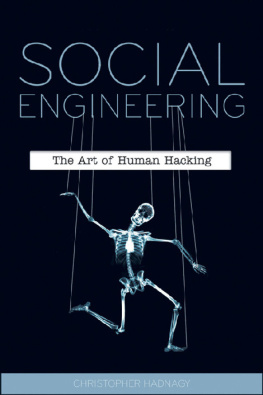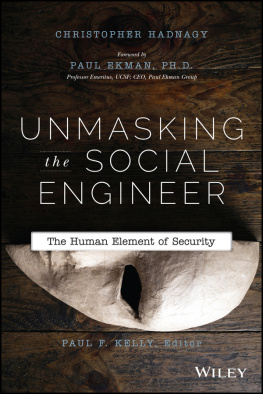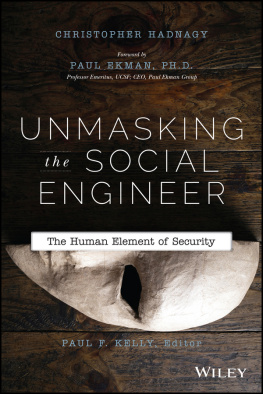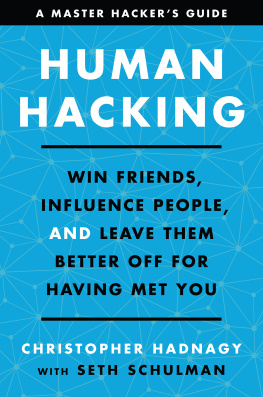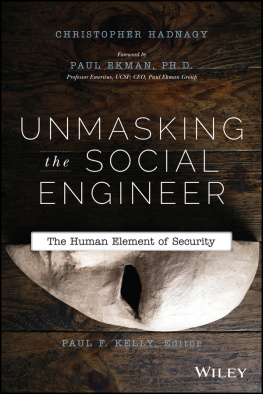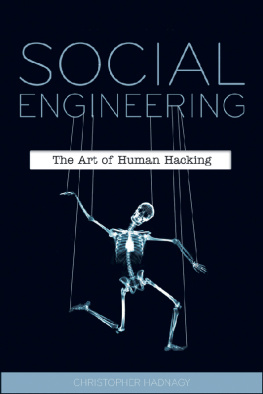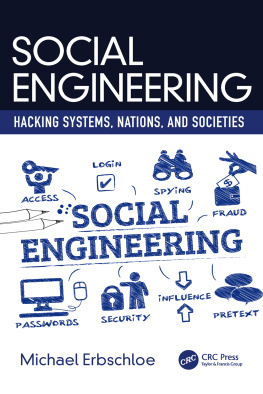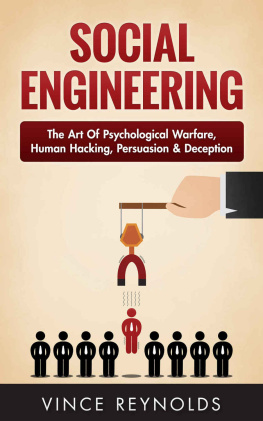Index
Numbers
7-38-55 Rule
419 scam
A
Abagnale, Frank Jr.
active listening, reflective responding and
aggressive approach to interrogation
Aharoni, Mati
program crashes
stamp collection
Air Force training, social incentives and
alcohol, eliciation and
alternate route
Amazon logo
anchoring
anger, microexpressions
anxiety
appearance, rapport building and
arm/hand placement
ask for what you want
assumed knowledge
assumptions in positive manipulation
assumptive questions
Asterisk
attacks
costliest
Dalai Lama
identifying
attention, holding
attractiveness
auctions, consistency
audio recording
cellular card
auditory thinkers
audits
auditor selection
goal setting
included items
authority
legal authority
organizational authority
social authority
symbols
symbols of
B
background checkers
BackTrack
BasKet
Dradis
Balmund, D.C., transactional model of communications
Bandiera, Oriana
Bandler, Richard
stories as direct instructions
bank accounts, Blippy
bank wire transfer, Stanley Mark Rifkin
Barankay, Iwan
Barlett, Frederic C.
baseline behavior for targets
BasKet
notes
screenshots
Bateson, Gregory
Battle for the Mind (Sargant)
beauty, success and
behavior changes in deception
Benford, Robert
Berlo, David, SMCR (Sender-Message-Channel-Receiver) model
BitDefender, password usage
black color association
Blippy
Bloomingdales purchase
blue color association
body language
Condon, William
matching
micro-movements
body posture, interrogation and
Boehm, Stephan G.
Boothman, Nicholas
brand names
Brandler, Richard, neurolinguistic programming
breathing rate
Bregler, Christoph
Bressert, Steve
brown color association
buffer, definition
buffer overflow
human
embedded commands
fuzzing
bump keys
Bump Proof BiLock
Butler, Judith
C
Caller ID spoofing
cameras
Campeau, Robert
Canadian CTU (Counter-Terrorism Unit), building plans
Candid Camera
carnivals, consistency and
case studies
DMV hack
importance of
Overconfident CEO
Social Security Administration hack
Theme Park Scandal
Top Secret 1
Top Secret 2
Cathie Marsh Centre for Census and Survey Information
celebrity endorsement of product
cellular card for audio recording
CeWl
CFB (Canadian Forces Base), security breach
Chebat, Jean-Charles
checks ripped up in car
Cialdini, Robert
authority and
commitment and consistency
nurse experiment
social proof
closed-ended questions
co-workers as security threat
coercion
coffee shop conversation
cognitive dissonance
color in manipulation
black
blue
brown
gold
green
orange
purple
red
white
yellow
combination approach to interrogation
comfort zones
commitment
carnivals
decisions and
game houses
gut feelings
information gathering and
communication
definition
energy and
forms
nonverbal portion
perception and
personal realities and
process
rules
questions and
rules
social engineers and
USB drive acceptance
verbal portion
communication model
channel
developing
feedback
information gathering and
message
receiver
Shannon-Weaver model
basis
problems for
SMCR (Sender-Message-Channel-Receiver) model
source
success
transactional model
communication modeling
Computer Security Institute survey
concession
contingent concessions
donation requests
installments
label concessions
negotiation and
reciprocity
conclusion, pretexting and
conditioning
marketing
Condon, William
body language
micro-movements
NLP (neurolinguistic programming)
confidential data in email
confrontation, positive
consensus
Conservative Movement
consistency
auctions
carnivals
decisions and
game houses
information gathering and
marketing
contempt, microexpressions
contingent concessions
contradictions in deception
controlling environment
conversation
education
facial expressions
greed
mastering art
natural behavior
counterterrorism, framing and
coupons as financial incentive
Covell, Michele
Craig, K.D.
Crandall, Christian
cults, manipulation and
cultural differences
gestures
reciprocity and
CUPP (Common User Passwords Profiler)
curiosity, rapport and
D
Dalai Lama
DarkMarket, Master Splynter
DarkReading, data breaches
Darwin, Charles, The Expression of the Emotions in Man and Animals
Davis, Harry
de Boulogne, Duchenne, smiling
deception detection
behavior changes
contradictions
hand gestures
hestitation
decision making, commitment and consistency
DeLozier, Judith
Turtles All the Way Down
denials, interrogation and
Department of Defense, interrogation and
DHS (Department of Homeland Security), elicitation
dialects, practicing
Dialects for the Stage (Machlin)
direct approach to interrogation
direct instructions, stories as
disaster victims
disgruntled employees
disgust, microexpressions
diversion
DMV hack (Mitnick)
doctors
documents, shredded
Dog Whisperer
dominant sense, discernment
donation requests
Dradis
dumpster diving pointers
Dunn, Patricia
Dunn and Bradstreet reports
E
economics, scarcity principle and
education, security and
egotistical approach to interrogation
Eidelman, Scott
Ekman, Paul
Emotions Revealed
FACS (Facial Action Coding System)
microexpressions
emotions
training
OSullivan, Maureen
Unmasking the Face
Wizards Project
elbow placement
electronic locks
elicitation
alcohol
appealing to ego
assumed knowledge
definition
DHS (Department of Homeland Security)
facial expressions and
false statements, deliberate
goals of
information gathering and
mutual interest
NSA (National Security Agency)
preloading and
questions
assumptive
closed-ended
leading
open-ended
pyramid approach
reasons it works
success
volunteering information
email, confidential data
embedded commands
emotional approach to interrogation
emotional attachments of target
emotions
controlling
gut feelings
influence
interferring
macroexpressions
microexpressions
anger
contempt
disgust
Ekman, Paul
fear
happiness
sadness
surprise
persuasion
targets behavior and
unversality
Emotions Revealed (Ekman)
empathy
disaster victims
insurance company
rapport and
employees
disgruntled
theft
energy, communication and
engineering, defintion
environment control
European laws, port scanners
exaggeration approach to interrogation
executive recruiters
Next page
